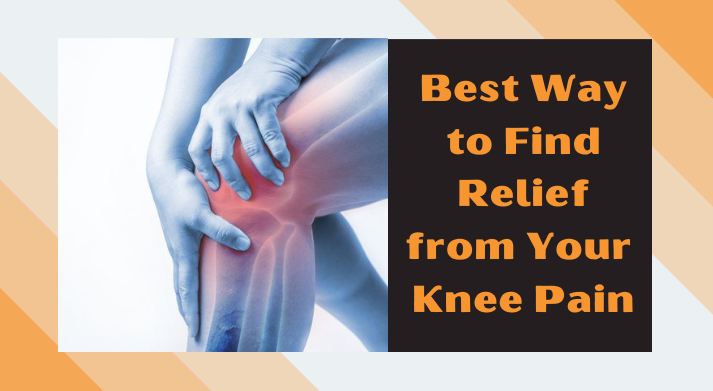In this article, we have reviewed Best Way to Find Relief from Your Knee Pain, Knee pain, mild swelling, and stiffness after not being active? This is osteoarthritis. And this is normal, especially with our age.

Best Way to Find Relief from Your Knee Pain
So reaching for this bottle of non-steroidal anti-inflammatory drugs such as ibuprofen or naproxen to try to control your symptoms may be a familiar habit.
Although you can take painkillers for osteoarthritis of the knee, they should be used with caution and only as part of a more comprehensive approach. “Everyone is unique, so we have to plan individual treatments,” says Carly Day, MD, a sports medicine specialist.
The Role Physical Therapy plays in the process
Physical therapy is beneficial. “Improving knee mobility and strength is helpful, but physical therapy for osteoarthritis of the knee focuses on strengthening the hips,” says Dr. Day. Weak hips put more than the pressure on the (knees). If your hips are strong, your knees need to work less when you get up from a chair or go upstairs.
According to Dr. Day, everyone with osteoarthritis of the knee should consult a physical therapist. Not only will you be taught the suitable types of exercises, but a physical therapist will also provide valuable instruction on the use of assistive devices (such as a cane or walker) and changes in activities (such as climbing stairs or getting out of a car). Pain
How to Get Moving Every Day
In addition to physical therapy, it is essential to include regular exercise in your daily routine.
“Joints are designed to move,” says Dr. Day. – Choose low-impact activities, such as cycling, or swimming.
Talk to your Doctor About a Knee Brace
Often a knee brace can help. “There is evidence that even a simple compression sleeve can reduce pain,” says Dr. Day. This is an excellent way to get started as you can get it from a drugstore.
You can also tell your doctor about customized loader braces. They put pressure on the part of the joint. The suitable mount for you will depend on the severity and location of the joint pain and mainly on the inside or outside of the common or in the knee cap.
Supplements for Those With Mild Pain
Dr. Day recommends trying supplements for people with mild pain, such as a mixture of glucosamine and chondroitin or turmeric spice. Evidence of glucosamine and chondroitin is mixed, but they are safe. So it might be worth trying. However, people who are allergic to shellfish cannot tolerate them. No effect will come immediately. Dr. Day recommends testing it for six to eight weeks. “If you feel better, great; if not, stop it,” she says.
Turmeric has anti-inflammatory properties, and there is some evidence that it is effective in treating knee pain. You can add turmeric to your diet or take it as a supplement. It can thin the blood, so people who take blood thinners should not use turmeric.
How to Use Pain Medications Properly
There are mainly two types of over-the-counter pain medications that can be used for osteoarthritis. Acetaminophen relieves pain but not inflammation. It can help with mild knee pain.
NSAIDs may be more effective because they both reduce pain and reduce inflammation. However, they do come with potential side risks. NSAIDs can irritate the lining of the liver, stomach, which can lead to ulcers or other stomach problems. They can also impair kidney function. Some NSAIDs can raise blood pressure. And these are associated with an up risk of heart disease. Because of the risks, Dr Day cautioned against taking NSAIDs regularly for long periods. Instead, she used NSAIDs for her patients in two ways. First, people who have a flare-up of pain can take it regularly for three to five days (i.e., every four to six hours, depending on the medication) and then stop. Second, they can be used for a long time, but only occasionally, once or twice a week, as needed. If you have been taking NSAIDs several times a day for a long time, Dr Day recommends reducing their use by using other treatment strategies as much as possible. She also recommends testing topical NSAIDs, such as diclofenac (Voltaren Gel®, Pennsaid®), with illness potential effects.
Opioid pain relievers are discouraged for the long-term best treatment of chronic knee pain. “Mild tramadol may be suitable for occasional use in some people,” says Dr Day.
Injections are Another low-risk Option
If other strategies do not provide adequate relief, injection therapy is a low-risk option.
Corticosteroid injections involve delivering this anti-inflammatory drug directly to the knee. The benefits are usually short-lived. But it varies from person to person. “I tell my patients that pain relief can last from a week to a year,” says Dr. Day. A precautionary note with corticosteroids is the ability to raise blood sugar, which is a concern for people with uncontrolled diabetes.
For possible lasting effects, an injection of hyaluronic acid (also called viscosupplementation) may be tried. “Hyaluronic acid is a substance that is abundant in healthy joints and not in arthritic knees,” says Dr Day. It takes longer to start working than corticosteroid injections, but the effects usually last six months to 9 months
Currently, research is done on the effectiveness of (PRP), which has not yet been covered. PRP involves:
- Drawing some blood.
- Turning it into a centrifuge.
- Injecting part of it into the knee.
If you can’t control your symptoms with a combination of these measures, she says, it may be time to talk to your doctor about the surgery.
So here are the Best Way to Find Relief from Your Knee Pain. if you like this article then please share this with your friends.
Also, Read Most Expensive Makeup Brands Click Here.
 Infoably Bringing you the Best Information
Infoably Bringing you the Best Information



